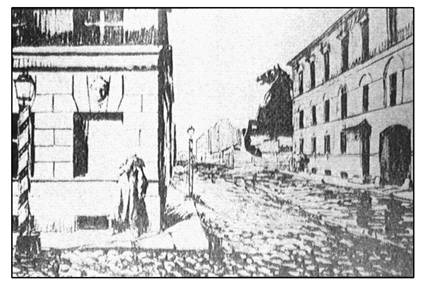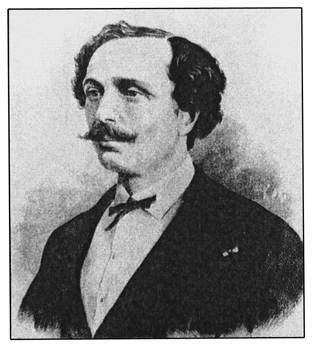Images

Peter the Great was challenging, demanding, deliberately outrageous, full of contradictions. His idea of establishing a new city in 1703—the future capital of the Russian Empire, St. Petersburg—appeared as the whim of an incredibly rich, reckless, and lucky gambler. Peter wanted to astonish Russia and the entire civilized world, and he succeeded.

(Top) At the unvelling of the monument to Peter the Great in 1782, the gratified Peterbugers could nt foresee the Etienne Falconet’s work would become the most important representation of their city.

(Above) The flooding of Peterburg in 1824 inpired the creation of Pushkin’s Bronze Horseman in 1833. Thus nature, culture, and history collided conpicuously.

(Right) The Bronze Horseman, at once dashing into the sky and rooted in stone, gave birth to the legend that as long the monument remained in place Peterburg would not perish.

(Right) The Petersburg mythos would not have existed without Alexander Pushkin, who transformed what had been no more than a monument to the great emperor—though an awesome one—into the very emblem of Petersburg, a sign of its majesty and endurance, and also into the symbol of the awful fate and terrible suffering that were to befall the city. Self-portrait of the poet, 1829.

(Above) The Bronze Horseman pursues poor Yevgeny: in Pushkin’s poem the statue represents not only Peter the Great and the city he founded but also the state itself. What is more important—the individual’s happiness or the city’s and the state’s triumph? Illustration by Alexander Benois for Pushkin’s Bronze Horseman, 1916.

(Right) Mikhail Glinka, “a kind of Russian Rossini”: his Valse-Fantaisie, in which erotic longing acquires an almost spiritual tone, was the wellspring of Petersburg music.

(Below) Imperial Petersburg in winter: view of the Neva River and St. Isaac’s Cathedral. Lithograph of the mid-nineteenth century.

(Left) Nikolai Gogol shattered the image of imperial Petersburg, creating his own obsessive vision in which the capital is not really a city at all, but a land of the living dead. Drawing by Nathan Altman, 1934, for Gogol’s Petersburg Tales.

(Below) Gogol’s Nevsky Prospect: “It’s all deceit, all dreams, it’s all not what it seems!”

(Above left) Fyodor Dostoyevsky on St. Petersburg: “I’m sorry, I don’t love it. Windows, holes—and monuments.” Wood engraving by Vladimir Favorsky, 1929.

(Above right) Dostoyevsky’s spectral Petersburg will exist as long as there is Russian literature. Mstislav Dobuzhinsky’s illustration, 1922, for Dostoyevsky’s White Nights creates an atmosphere of quiet despair.

(Right) Modest Mussorgsky, who created “Dostoyevskian” operas, died of acute alcoholism. This portrait was done by Ilya Repin in Petersburg’s military hospital just ten days before the composer’s death in 1881.

(Above) Petipa’s Sleeping Beauty, set to Tchaikovsky’s music, inspired the unprecedented re-evaluation of the Petersburg mythos: it was transformed from sinister to benign, from dour to luminous. An 1890 photograph, taken after the ballet’s premiere at the Maryinsky theater.

(Left) Marius Petipa endowed his ballets with a vision of Petersburg’s grandeur and sense of architectural harmony and classical purity.

(Left) Peter Tchaikovsky’s music was a forewarning for Petersburgers of the coming collisions and catastrophes.

(Below) Tchaikovsky’s opera The Queen of Spades, based on Pushkin, brought its listeners “the poison of Petersburg nights, the sweet mirage of its ghostly images.” Design for the 1931 production by Vladimir Dmitriev.

(Top) A group portrait of Mir iskusstva (World of Art) by one of its members, Boris Kustodiev. This dynamic collective changed the course of Petersburg arts and crafts, but many of its members ended in exile after the Bolsheviks came to power in 1917.

(Above left) Alexander Benois, guiding spirit of Mir iskusstva, became one of the most influential makers of the Petersburg mythos at the turn of the century. Portrait by Leon Bakst, 1898.

(Above right) The organizational genius and impeccable taste of Sergei Diaghilev brought Petersburg art, music, and ballet into the world arena. Portrait by Valentin Serov, 1908.

(Top left) Michel Fokine, who choreographed the first plotless ballet, Les Sylphides, died in exile in New York in 1942.

(Top right) Igor Stravinsky, for whom St. Petersburg was dearer “than any other city in the world,” helped create, along with Vladimir Nabokov and George Balanchine, a powerful new vision of Petersburg in the West. Portrait, 1933, by Vassily Shukhaev, an émigré who returned to Leningrad and spent ten years in Stalin’s labor camps.

(Opposite bottom) Petrouchka, a collaborative effort by Stravinsky, Benois, and Fokine, was the first work to offer the Western audience an idealized image of Petersburg. This is Benois’ sketch for the 1911 Paris premiere.

(Top left) Nikolai Rimsky-Korsakov, founding father of the highly influential school of composition to which Stravinsky, Prokofiev, and Shostakovich—three of the most popular composers of the twentieth century—belonged.

(Top right) Sergei Prokofiev’s music ranged from neoclassicist to futuristic, reflecting the vitality of the artistic scene in prerevolutionary Petrograd. Portrait by Alexander Benois.

(Right) During Alexander Glazunov’s tenure as director of the St. Petersburg Conservatory, that institute produced some of the greatest performers of the century. Photo of Glazunov with youthful violinist Nathan Milstein, 1923.

(Above left) Mikhail Kuzmin was the first of his countrymen to introduce an openly homosexual theme into Russian literature. Portrait by Konstantin Somov, 1909.

(Above right) Matilda Kchessinska, notorious star of the Imperial Ballet and mistress of Nicholas II when he was heir to the throne, was proof of the success to which a woman artist from the demi-monde could aspire in St. Petersburg.

(Right) Alexander Blok, the most famous Petersburg poet of his time: “In those days there wasn’t a single ‘thinking’ young woman in Russia who wasn’t in love with Blok.”

(Opposite top) In her poetry and her person Anna Akhmatova came to symbolize the endurance of the city on the Neva, and she was its courageous voice. Portrait by Nathan Altman, 1914.

(Opposite bottom) Akhmatova with her first husband, poet Nikolai Gumilyov, and their son, Lev: all three were destined to be swept up in the city’s tragic fate. Photo, 1916.

(Top) Seeing off futurist Benedikt Livshits to war in 1914 after the city was renamed Petrograd. From left: poet Osip Mandelstam, critic Kornei Chukovsky, Livshits, artist Yuri Annenkov. Only Chukovsky lived to an old age in Russia; Annenkov fled to Paris, and Mandelstam and Livshits perished in the years of Stalin’s Great Terror.

(Bottom) At the futurist exhibition in Petrograd of 1915, Black Square by Casimir Malevich is seen hung high up at the corner of the gallery, the position traditionally reserved for sacred icons. It did, in fact, become the icon of abstract art.

(Above) Revolution in Petrograd, 1917: the rubble consists of burned police files.

(Left) Vladimir Lenin moved the capital of the country from Petrograd back to Moscow in 1918. He disliked the city intensely, but, ironically, after his death in 1924 it was renamed Leningrad in his honor. Portrait drawn from life by Nathan Altman, 1920.

(Top) Propaganda porcelain: exquisite dishes in a hungry city. Tray, 1921, by Sergei Chekhonin, who died in exile in 1936.

(Bottom) Propaganda poster, 1920, by Vladimir Lebedev: Petrograd’s revolutionary artists attempted to reinvent the role of art in the city’s life.

(Top left) Daring and innovative: George Balanchine in Petrograd, 1923, partnering his first wife, Tamara Geva, in a pas de deux that he himself choreographed.

(Top right) Levky Zheverzheyev, Tamara’s father and prominent patron of modern art; his role in developing Balanchine’s taste and artistic outlook cannot be overestimated.

(Right) Vladimir Dmitriev, cofounder with Balanchine of the experimental Young Ballet. He received the Stalin Prize for his stage designs four times, but after the arrest of his wife by the secret police he lived in fear and died of a heart attack at the age of 47.

(Above left) The cover of the booklet containing drawings for Fyodor Lopukhov’s neoclassical ballet The Grandeur of the Universe; Balanchine fully absorbed Lopukhov’s bold ideas.

(Above right) “Speaking” costume design for the avant-garde production of Gogol’s The Inspector General in Petrograd, 1927. The policeman’s uniform depicts chains, lock and keys, and prisoners behind bars.

(Right) Vladimir Lebedev’s illustration for a children’s book about a circus; the book was attacked as “formalist” by the authorities. In 1931 a number of Leningrad writers and artists for children were arrested on charges of “counterrevolutionary convictions.”

(Opposite top) Film directors Grigory Kozintsev (at left) and Leonid Trauberg (second from right), founders of the Factory of the Eccentric Actor, with their colleagues. Shostakovich wrote music for their films.

(Above left) Dmitri Shostakovich was the darling of the Leningrad artistic élite until Pravda’s 1936 editorial denounced his opera Lady Macbeth of the Mtsensk District as “muddle,” not music. Portrait by Nikolai Akimov, a prominent stage director, 1933.

(Above right) The satirical writer Mikhail Zoshchenko in a 1923 photograph, at the height of his enormous popularity. After party boss Andrei Zhdanov called him a “scoundrel of literature,” Zoshchenko was no longer published. He died in 1958, broken in spirit and half mad.

(Opposite top) Joseph Stalin, with Zhdanov, at the bier of Leningrad Party leader Sergei Kirov, who was killed in 1934 on—it is now believed—Stalin’s orders. Stalin was hostile to Leningrad, regarding it as a hotbed of political and cultural opposition, and he used Kirov’s murder as a pretext for mass repressions.

(Above left) “Stunned by a blow from the back, I fell, then started to rise; but there was another blowin the face. I lost consciousness.” Thus Leningrad poet Nikolai Zabolotsky described one of his interrogations by the secret police in 1938.

(Above middle) A few months before his influential book on Dostoyevsky appeared in 1929, Mikhail Bakhtin was arrested by secret police, and, in the course of an operation to liquidate Leningrad’s underground philosophical and religious circles, he was sent into internal exile.

(Above right) A leading Leningrad dadaist, Daniil Kharms was arrested in 1941, declared mentally ill, and placed in a prison hospital, where he soon died.

(Right top) Threatening the city with obliteration, the 900-day siege of Leningrad by the Germans in World War II claimed innumerable lives and cemented the new image of the city as martyr. Poster by Nikolai Tyrsa, 1941.

(Right bottom) After the war, a new generation of Leningrad artists challenged the official dogma: a drawing by Richard Vasmi mockingly depicts one of the city’s many monuments to Lenin.

(Top left) As did Stravinsky’s reappearance after decades of exile, Balanchine’s triumphant visit to Leningrad in 1962 reconnected émigré and native halves of the modern Petersburg culture. The reconnection took hold slowly; Nabokov’s works were accepted in Russia only in the late 1980s. Photo of Balanchine by Marianna Volkov.

(Top right) The poetry of Joseph Brodsky, exiled to the West in 1972 and awarded the Nobel Prize in 1987, opened a new chapter in the life of Petersburg’s cultural tradition. He, too, is now published widely in Russia. Photo by Marianna Volkov.

(Above) For the younger generations, Akhmatova’s late work fused past and present threads in the city’s self-image. Solomon Volkov (at left) is seen with his group after playing Shostakovich’s Ninth String Quartet for Akhmatova at her summer dacha. Photo courtesy ofSlava Osipov, 1965.

(Top left) The prose of Andrei Bitov presented an unmistakably Petersburg type—restrained, observant, hiding a profound ambivalence behind a mask of irony. Photo by Marianna Volkov.

(Top right) Conductor Valery Gergiev revitalized the Maryinsky Theater, making it once again a premier Russian opera house. Photo by Marianna Volkov.

(Above left) In his rebellious songs rock star Boris Grebenshikov expressed the yearnings of multitudes of the city’s alienated youth. Photo by Marianna Volkov.

(Above right) Alexander Kushner, describing the city’s twilight beauty in his poems, makes a ritual journey “from Leningrad to Petersburg.” Photo by Marianna Volkov.

This monument to Peter the Great by Mihail Chemiakin was unveiled in 1991, just before the city won the right to return to its historical name, St. Petersburg. Photo courtesy of Mihail Chemiakin.
 ТЕЛЕГРАМ
ТЕЛЕГРАМ Книжный Вестник
Книжный Вестник Поиск книг
Поиск книг Любовные романы
Любовные романы Саморазвитие
Саморазвитие Детективы
Детективы Фантастика
Фантастика Классика
Классика ВКОНТАКТЕ
ВКОНТАКТЕ